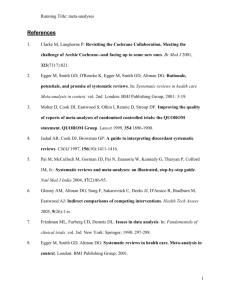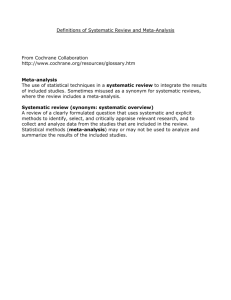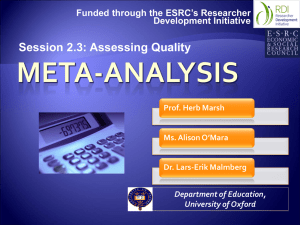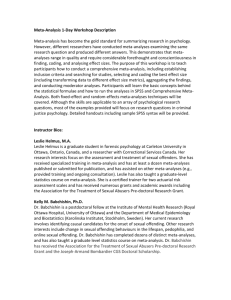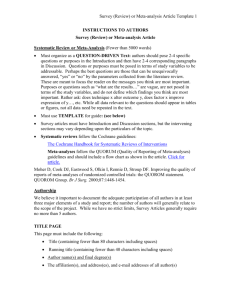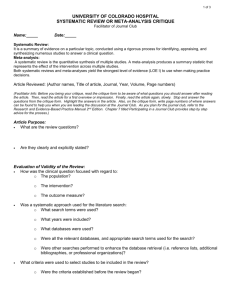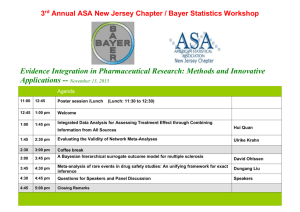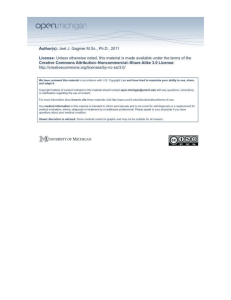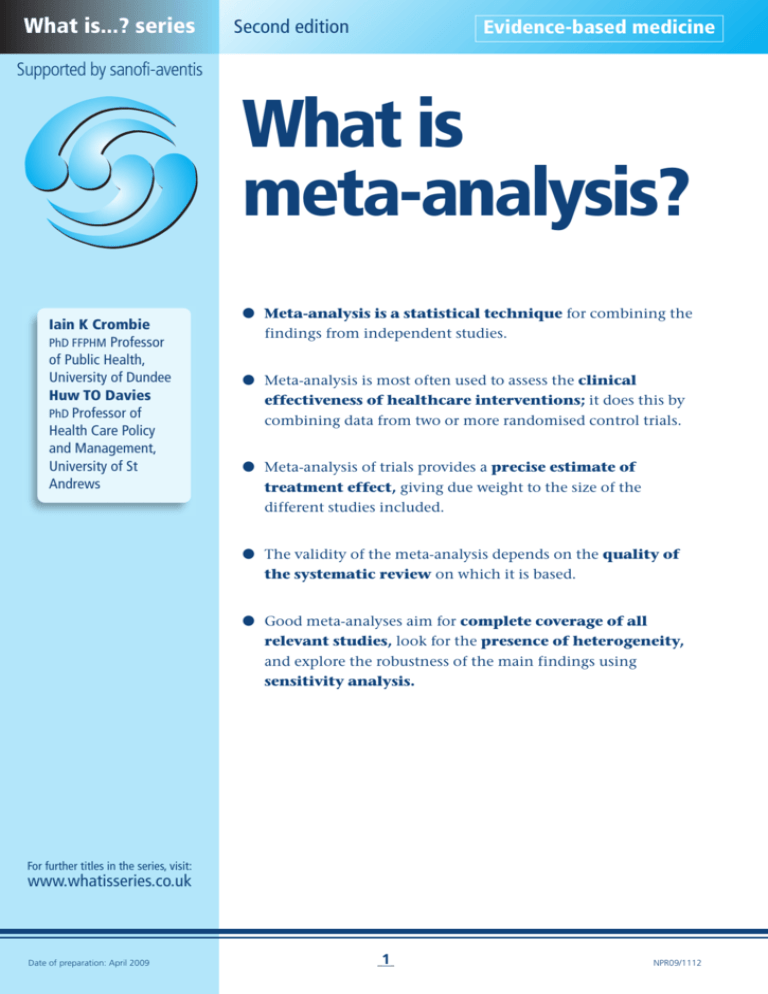
What is...? series
Second edition
Evidence-based medicine
Supported by sanofi-aventis
What is
meta-analysis?
Iain K Crombie
PhD FFPHM Professor
of Public Health,
University of Dundee
Huw TO Davies
PhD Professor of
Health Care Policy
and Management,
University of St
Andrews
● Meta-analysis is a statistical technique for combining the
findings from independent studies.
● Meta-analysis is most often used to assess the clinical
effectiveness of healthcare interventions; it does this by
combining data from two or more randomised control trials.
● Meta-analysis of trials provides a precise estimate of
treatment effect, giving due weight to the size of the
different studies included.
● The validity of the meta-analysis depends on the quality of
the systematic review on which it is based.
● Good meta-analyses aim for complete coverage of all
relevant studies, look for the presence of heterogeneity,
and explore the robustness of the main findings using
sensitivity analysis.
For further titles in the series, visit:
www.whatisseries.co.uk
Date of preparation: April 2009
1
NPR09/1112
What is
meta-analysis?
What is meta-analysis?
Trials, systematic reviews
and meta-analysis
In many medical specialties it is common
to find that several trials have attempted
to answer similar questions about clinical
effectiveness; for example: Does the new
treatment confer significant benefits
compared with the conventional
treatment? Often many of the
individual trials will fail to show a
statistically significant difference between
the two treatments. However, when the
results from the individual studies are
combined using appropriate techniques
(meta-analysis), significant benefits of
treatment may be shown. A good example
of this is a retrospective review of the
evidence on the effectiveness of
thrombolytic therapy for the prevention
of myocardial infarction.1 The study
showed that had meta-analysis been
conducted at an early stage, it would have
demonstrated the benefits of
thrombolytic therapy. Instead, experts
remained unaware of its benefits for
many years and patients were not given
an effective therapy. Meta-analyses are
now a hallmark of evidence-based
medicine.
Systematic reviews
Systematic review methodology is at the
heart of meta-analysis. This stresses the
need to take great care to find all the
relevant studies (published and
unpublished), and to assess the
methodological quality of the design
and execution of each study.2 The
objective of systematic reviews is to
present a balanced and impartial
summary of the existing research,
enabling decisions on effectiveness
to be based on all relevant studies of
adequate quality. Frequently, such
systematic reviews provide a quantitative
(statistical) estimate of net benefit
aggregated over all the included
studies. Such an approach is termed
a meta-analysis.
Date of preparation: April 2009
2
Benefits of meta-analyses
Meta-analysis offers a rational and helpful
way of dealing with a number of practical
difficulties that beset anyone trying to
make sense of effectiveness research.
Overcoming bias
The danger of unsystematic (or narrative)
reviews, with only a portion of relevant
studies included, is that they could
introduce bias. Certain (perhaps
favourable) reports may be more likely to
be included in a review than those which
show no significant differences; and
informal synthesis may be tainted by the
prior beliefs of the reviewer. Meta-analysis
carried out on a rigorous systematic
review can overcome these dangers –
offering an unbiased synthesis of the
empirical data.
Precision
The precision with which the size of any
effect can be estimated depends to a large
extent on the number of patients studied.
Meta-analyses, which combine the results
from many trials, have more power to
detect small but clinically significant
effects. Furthermore, they give more
precise estimates of the size of any effects
uncovered. This may be especially
important when an investigator is looking
for beneficial (or deleterious) effects in
specific subgroups of patients. Individual
studies may contain too few patients in
the subgroup of interest to be
informative. However, the systematic
aggregation of data from many individual
studies gives a clearer picture, particularly
through use of the technique of metaregression (see below).
Transparency
It is not simply the case that meta-analyses
can always exclude bias more readily than
other forms of review. Their advantage
also lies in the openness with which good
meta-analyses reveal all the decisions that
have been taken throughout the process
NPR09/1112
What is
meta-analysis?
of achieving the final aggregate effect
sizes. Thus, good meta-analyses should
allow readers to determine for themselves
the reasonableness of the decisions taken
and their likely impact on the final
estimate of effect size.
Requirements for
meta-analysis
The main requirement for a
worthwhile meta-analysis is a wellexecuted systematic review.3 However
competent the meta-analysis, if the
original review was partial, flawed or
otherwise unsystematic, then the metaanalysis may provide a precise quantitative
estimate that is simply wrong. The main
requirement of systematic review is easier
to state than to execute: a complete,
unbiased collection of all the original
studies of acceptable quality that examine
the same therapeutic question. There are
many checklists for the assessment of the
quality of systematic reviews;4 however,
the QUOROM statement (quality
of reporting of meta-analyses) is
particularly recommended.5
Calculating effect sizes
Meta-analysis requires a comprehensive
search strategy which interrogates several
electronic databases (for example,
MEDLINE, EMBASE, Cochrane Central
Register of Controlled Trials). Handsearching of key journals and checking of
the reference lists of papers obtained is
also recommended.6 The search strategy –
the key terms used to search the database
– needs to be developed with care. The
strategy is written as a sequence of
requirements: include papers with
specified terms, exclude papers that do
not meet certain criteria (for example, age
or diagnostic group), only include studies
that follow certain research designs (for
example, randomised controlled trials).
Clinical trials commonly present their
results as the frequency of some outcome
(such as a heart attack or death) in the
intervention groups and the control
group. For meta-analysis these are usually
summarised as a ratio of the frequency of
the events in the intervention to that in
the control group. In the past the most
common summary measure of effect size
was the odds ratio, but now the risk
ratio (relative risk) can be given.
Although they are technically different,
the odds ratios and relative risks are
usually interpreted in the same way.11
Thus, a ratio of 2 implies that the defined
outcome happens about twice as often in
the intervention group as in the control
group; an odds ratio of 0.5 implies
around a 50% reduction in the defined
event in the treated group compared with
the controls.
The findings from individual studies
can be combined using an appropriate
statistical method.12 Separate methods are
used for combining odds ratios, relative
risks and other outcome measures such as
risk difference or hazard ratio. The
methods use a similar approach in which
the estimate from each study is weighted
by the precision of the estimate.
Quality assessment
Checking for publication bias
Once all relevant studies have been
identified, decisions must be taken about
A key concern is publication bias, as
clinical trials that obtain negative
Conducting meta-analyses
Location of studies
Date of preparation: April 2009
which studies are sufficiently well
conducted to be worth including. This
process may again introduce bias, so good
meta-analyses will use explicit and
objective criteria for inclusion or
rejection of studies on quality grounds.7
There is a bewildering array of scales for
assessing the quality of the individual
clinical trials.8 Two scales that are
commonly used are those developed by
Chalmers et al9 and Jadad et al.10 Perhaps
more important than the scale used is
whether a scale has been used at all. Once
a quality score has been assigned, the
impact of excluding low quality studies
can be assessed by sensitivity analysis
(see below).
3
NPR09/1112
What is
meta-analysis?
findings (that is, no benefit of treatment)
are less likely to be published than those
that conclude the treatment is effective.13
One simple way of assessing the likely
presence of publication bias is to
examine a funnel plot.14 Funnel plots
display the studies included in the metaanalysis in a plot of effect size against
sample size15 (or some other measure of
the extent to which the findings could be
affected by the play of chance).16 As
smaller studies have more chance
variability than larger studies, the
expected picture is one of a symmetrical
inverted funnel (Figure 1).17 If the plot is
asymmetric, this suggests that the metaanalysis may have missed some trials –
usually smaller studies showing no effect.
(Note that asymmetry could also occur if
small studies tend to have larger effect
size,18 so the conclusion of publication
bias should be a cautious one.)19
The funnel plot has some limitations;
for example, it can sometimes be difficult
to detect asymmetry by eye.20 To help
with this, formal statistical methods have
been developed to test for heterogeneity.
Egger’s regression test14 has been widely
used to test for publication bias. It tests
whether small studies tend to have larger
effect sizes than would be expected
(implying that small studies with small
effects have not been published). Another
regression test, which in some
circumstances may be better than Egger’s
test, has been proposed.15 However, care is
needed in the interpretation of the
findings whatever test has been used.
There is currently no clear direction in
recent literature to indicate when to use
each test.
Sensitivity analyses
Because of the many ways in which
decisions taken about selection,
inclusion and aggregation of data may
affect the main findings, it is usual for
meta-analysts to carry out some
sensitivity analysis. This explores the
ways in which the main findings are
changed by varying the approach to
aggregation. A good sensitivity analysis
will explore, among other things, the
effect of excluding various categories of
studies; for example, unpublished studies
or those of poor quality. It may also
examine how consistent the results are
across various subgroups (perhaps
defined by patient group, type of
intervention or setting). In meta-analyses
without sensitivity analyses, the reader
has to make guesses about the likely
impact of these important factors on the
key findings.
Streptokinase
Intravenous magnesium
105–
105–
Number of patients
104–
Number of patients
ISIS-4
Meta-analysis
●
103–
●
●
102– ●
●
●
●●
●
●
●● ●
●
●
104–
ISIS-2
GISSI-I
Meta-analysis
●
103–
●● ●
● ●●
●
●
●
●
●
●●
●
●
102–
● ●
10–l
0.1
l
1
Odds ratio
l
10
10–l
0.1
●
●
l
l
1
Odds ratio
10
Points indicate odds ratios from small and medium sized trials, diamonds indicate combined odds ratios with 95% confidence
intervals from meta-analysis of these trials, and squares indicate odds ratios with 95% confidence intervals from mega trials
Figure 1. Funnel plots used to identify possible missing studies17
Date of preparation: April 2009
4
NPR09/1112
What is
meta-analysis?
Beta-blocker deaths
No (%) of deaths/patients
Study
Logrank
Variance
observed – observed –
expected
expected
Beta-blocker
Control
Wilcox (oxprenolol)
14/157 (8.9)
10/158 (8.9)
2.0
5.6
Norris (propanolol)
21/226 (9.3)
24/228 (9.3)
–1.4
10.2
Multicentre (propanolol)
15/100 (15.0)
12/95 (12.6)
1.2
5.8
Baber (propanolol)
28/355 (7.9)
27/365 (7.4)
0.9
12.7
Andersen (alprenolol)
61/238 (25.6)
64/242 (26.4)
–1.0
23.2
Balcon (propanolol)
14/56 (25.0)
15/58 (25.9)
–0.2
5.5
Barber (practolol)
47/221 (21.3)
53/228 (23.2)
–2.2
19.5
Wilcox (propanolol)
36/259 (13.9)
19/129 (14.7)
–0.7
10.5
CPRG (oxprenolol)
9/177 (5.1)
5/136 (3.6)
1.1
3.3
102/1,533 (6.7)
127/1,520 (8.4)
–13.0
53.0
Barber (propanolol)
10/52 (19.2)
12/47 (25.5)
–1.6
4.3
BHAT (propanolol)
138/1,916 (7.2)
188/1,921 (9.8)
–24.8
74.6
Multicentre (timolol)
98/945 (10.40
152/939 (16.2)
–27.4
54.2
Hjalmarson (metoprolol)
40/698 (5.7)
62/697 (8.9)
–11.0
23.7
Wilhelmsson (alprenolol)
7/114 (6.1)
14/116 (12.1)
–3.4
4.8
640/7,047 (9.1)
784/6,879 (11.4)
–81.6
310.7
Multicentre (practolol)
Total*
Ratio of crude death rates (99% CI)
beta-blocker:control
0
Reduction 23.1% (standard error 5.0) p<0.0001
0.5
1.0
beta-blocker better
Heterogeneity between 15 trials: χ2 = 13.9; df = 14; p>0.1
1.5
2.0
beta-blocker worse
Treatment effect p<0.0001
* 95% confidence interval as shown for the odds ratio
Figure 2. Presentation of the findings from a meta-analysis21
Presenting the findings
Forest plot
The usual way of displaying data from a
meta-analysis is by a pictorial
representation (sometimes known as a
Forest plot). An example is shown in
Figure 2.21 This displays the findings from
each individual study as a blob or square,21
with squares towards the left side
indicating the new treatment to be better,
whereas those on the right indicate the
new treatment to be less effective. The size
of the blob or square is proportional to the
precision of the study (roughly speaking,
the sample size). A horizontal line (usually
the 95% confidence interval) is drawn
around each of the studies’ squares to
represent the uncertainty of the estimate
of the treatment effect. The aggregate
Date of preparation: April 2009
5
effect size obtained by combining all the
studies is usually displayed as a diamond.
Heterogeneity
A major concern about meta-analyses is
the extent to which they mix studies that
are different in kind (heterogeneity). One
widely quoted definition of meta-analysis
is: ‘a statistical analysis which
combines or integrates the results of
several independent clinical trials
considered by the analyst to be
“combinable”’.22 The key difficulty lies
in deciding which sets of studies are
‘combinable’. Clearly, to get a precise
answer to a specific question, only studies
that exactly match the question should be
included. Unfortunately, studies can differ
on the types of patient studied (disease
NPR09/1112
What is
meta-analysis?
severity or co-morbidity), the nature of
local healthcare facilities, the
intervention given and the primary
endpoint (death, disease, disability).
These systematic differences between
studies can influence the amount of
treatment benefit (the effect size), leading
to heterogeneity between studies.
Meta-analyses should test for the
existence of heterogeneity. A test which
was commonly used is Cochrane’s Q, a
statistic based on the chi-squared test.23
Unfortunately, this test is thought to have
low power; that is, it may sometimes fail
to detect heterogeneity when it is present.
To try to overcome this, a second test, the
I2 statistic, was developed.24 This test
seems attractive because it scores
heterogeneity between 0% and 100%.
Further, a rule of thumb was proposed,
with 25% corresponding to low
heterogeneity, 50% to moderate and 75%
to high. Subsequent research suggests that
this test may also have low power,23 so it
too has to be interpreted cautiously.
The presence or absence of
heterogeneity influences the subsequent
method of analysis. If heterogeneity is
absent, then the analysis employs what is
termed fixed-effects modelling. This
assumes the size of treatment effect is the
same (fixed) across all studies and the
variation seen between studies is due only
to the play of chance. Random-effects
models assume that the treatment effect
really does vary between studies. Such
models tend to increase the variance of
the summary measure, making it more
difficult to obtain significant results.
When the amount of heterogeneity is
large, it may even be inappropriate to
calculate an overall summary measure of
effect size. Unfortunately, there is no
reliable objective measure to decide when
pooling is appropriate. Thus, a rule of
thumb is given above. The technique of
meta-regression is introduced because it
provides one way of overcoming the
problem of heterogeneity.
Meta-regression
When heterogeneity is detected, it is
important to investigate what may have
Date of preparation: April 2009
6
caused it. Meta-regression is a technique
which allows researchers to explore which
types of patient-specific factors or study
design factors contribute to the
heterogeneity. The simplest type of metaregression uses summary data from each
trial, such as the average effect size,
average disease severity at baseline, and
average length of follow-up. This
approach is valuable, but it has only
limited ability to identify important
factors. In particular, it struggles to
identify which patient features are related
to the size of treatment effect.25
Fortunately, another approach, using
individual patient data, will give answers
to the important question: what types of
patients are most likely to benefit from
this treatment? Using individual patient
data allows much greater flexibility for
the analysis, and issues can be explored
that were not covered in the published
trials. However, obtaining the original
patient data from each of the trials is
challenging.
Limitations
Assessments of the quality of systematic
reviews and meta-analysis often identify
limitations in the ways they were
conducted.26,27 Flaws in meta-analysis can
arise through failure to conduct any of
the steps in data collection, analysis and
presentation described above. To
summarise:
● Was the search strategy comprehensive
and likely to avoid bias in the studies
identified for inclusion?
● Was publication bias assessed?
● Was the quality of the individual
studies assessed using an appropriate
checklist of criteria?
● Was combined effect size calculated
using appropriate statistical methods?
● Was heterogeneity considered and
tested for?
Conflict with new experimental data
Meta-analyses seek new knowledge from
existing data. One test of the validity of
this new knowledge is to compare the
results from meta-analyses with
NPR09/1112
What is
meta-analysis?
subsequent findings from large-scale,
well-conducted, randomised controlled
trials (so-called ‘mega trials’). The
results of such comparisons have, so far,
been mixed – good agreement in the
majority of cases but some discrepancies
in others.28,29 For example, one such
exercise led to publication of a paper
subtitled ‘Lessons from an “effective,
safe, simple intervention” that wasn’t’
(use of intravenous magnesium after
heart attacks).17 With the benefit of
hindsight, the flaws in meta-analyses
that have been subsequently
contradicted by data from mega trials can
often be uncovered. Such post-mortems
have led to a number of methodological
improvements (such as funnel plots) and
a greater understanding of the pitfalls
outlined above.
Conclusion
Meta-analyses offer a systematic and
quantitative approach to synthesising
evidence to answer important therapeutic
questions. Nonetheless, pitfalls abound in
the execution of meta-analyses and they
are fundamentally limited by the quality
of the underlying studies (the so-called
GIGO principle of ‘garbage in, garbage
out’). For healthcare managers and
clinicians, careful reviewing of published
meta-analyses and a balanced assessment
of their deficiencies is likely to become an
increasingly important way of resolving
therapeutic uncertainty.
The field of meta-analysis is in a period
of rapid development, with theoretical
and methodological advances as well as
the findings from empirical research.
However, two recent books provide
excellent reviews of current knowledge
and offer far more detail than can be
presented in this short briefing
document. See below for further reading.
References
1. Antman EM, Lau J, Kupelnick B, Mosteller F, Chalmers TC. A
comparison of results of meta-analyses of randomized control
trials and recommendations of clinical experts. Treatments for
myocardial infarction. JAMA 1992; 268: 240–248.
2. Mulrow CD. Rationale for systematic reviews. BMJ 1994;
309: 597–599.
3. Bailar JC 3rd. The promise and problems of meta-analysis.
N Engl J Med 1997; 337: 559–561.
4. Shea B, Dubé C, Moher D. Assessing the quality of reports
Date of preparation: April 2009
7
of systematic reviews: the QUOROM statement compared to
other tools. In: Egger M, Smith GD, Altman DG (eds).
Systematic Reviews in Health Care: Meta-analysis in context, 2nd
edn. London: BMJ Publishing Group, 2001.
5. Moher D, Cook DJ, Eastwood S et al. Improving the quality
of reports of meta-analyses of randomised controlled trials:
the QUOROM statement. Quality of Reporting of Metaanalyses. Lancet 1999; 354: 1896–1900.
6. Higgins JPT, Green S. Cochrane Handbook for Systematic
Reviews of Interventions 4.2.6.
http://cochrane.org/resources/handbook/Handbook4.2.6Sep
2006.pdf (last accessed 28 October 2008)
7. Cook DJ, Sackett DL, Spitzer WO. Methodologic guidelines
for systematic reviews of randomized control trials in health
care from the Potsdam Consultation on Meta-Analysis. J Clin
Epidemiol 1995; 48: 167–171.
8. Jüni P, Altman DG, Egger M. Assessing the quality of
randomised controlled trials. In: Egger M, Smith GD, Altman
DG (eds). Systematic Reviews in Health Care: Meta-analysis in
context, 2nd edn. London: BMJ Publishing Group, 2001.
9. Chalmers TC, Smith H Jr, Blackburn B et al. A method for
assessing the quality of a randomized control trial. Control
Clin Trials 1981; 2: 31–49.
10. Jadad AR, Moore RA, Carroll D et al. Assessing the quality
of reports of randomized clinical trials: is blinding necessary?
Control Clin Trials 1996; 17: 1–12.
11. Davies HT, Crombie IK, Tavakoli M. When can odds ratios
mislead? BMJ 1998; 316: 989–991.
12. Deeks JJ, Altman DG, Bradburn MJ. Statistical methods for
examining heterogeneity and combining results from several
studies in meta-analysis. In: Egger M, Smith GD, Altman DG
(eds). Systematic Reviews in Health Care: Meta-analysis in
context, 2nd edn. London: BMJ Publishing Group, 2001.
13. Thornton A, Lee P. Publication bias in meta-analysis: its
causes and consequences. J Clin Epidemiol 2000; 53: 207–216.
14. Egger M, Davey Smith G, Schneider M, Minder C. Bias in
meta-analysis detected by a simple, graphical test. BMJ 1997;
315: 629–634.
15. Peters JL, Sutton AJ, Jones DR, Abrams KR, Rushton L.
Comparison of two methods to detect publication bias in
meta-analysis. JAMA 2006; 295: 676–680.
16. Sterne JA, Egger M. Funnel plots for detecting bias in
meta-analysis: guidelines on choice of axis. J Clin Epidemiol
2001; 54: 1046–1055.
17. Egger M, Smith GD. Misleading meta-analysis. BMJ 1995;
311: 752–754.
18. Sterne JA, Egger M, Smith GD. Systematic reviews in
health care: Investigating and dealing with publication and
other biases in meta-analysis. BMJ 2001; 323: 101–105.
19. Lau J, Ioannidis JP, Terrin N, Schmid CH, Olkin I. The case
of the misleading funnel plot. BMJ 2006; 333: 597–600.
20. Terrin N, Schmid CH, Lau J. In an empirical evaluation of
the funnel plot, researchers could not visually identify
publication bias. J Clin Epidemiol 2005; 58: 894–901.
21. Lewis S, Clarke M. Forest plots: trying to see the wood and
the trees. BMJ 2001; 322: 1479–1480.
22. Huque MF. Experiences with meta-analysis in NDA
submissions. Proc Biopharm Section Am Stat Assoc 1988; 2:
28–33.
23. Ioannidis JP, Patsopoulos NA, Evangelou E. Uncertainty in
heterogeneity estimates in meta-analyses. BMJ 2007; 335:
914–916.
24. Higgins JP, Thompson SG, Deeks JJ, Altman DG.
Measuring inconsistency in meta-analyses. BMJ 2003; 327:
557–560.
25. Schmid CH, Stark PC, Berlin JA, Landais P, Lau J. Metaregression detected associations between heterogeneous
treatment effects and study-level, but not patient-level,
factors. J Clin Epidemiol 2004; 57: 683–697.
26. Biondi-Zoccai GG, Lotrionte M, Abbate A et al.
Compliance with QUOROM and quality of reporting of
overlapping meta-analyses on the role of acetylcysteine in the
prevention of contrast associated nephropathy: case study.
BMJ 2006; 332: 202–209.
27. Moja LP, Telaro E, D’Amico R et al. Assessment of
methodological quality of primary studies by systematic
reviews: results of the metaquality cross sectional study. BMJ
2005; 330: 1053.
28. LeLorier J, Gregoire G, Benhaddad A, Lapierre J, Derderian F.
Discrepancies between meta-analyses and subsequent large
randomized, controlled trials. N Engl J Med 1997; 337: 536–542.
29. Villar J, Carroli G, Belizan JM. Predictive ability of metaanalyses of randomised controlled trials. Lancet 1995; 345:
772–776.
Further reading
1. Egger M, Smith GD, Altman DG (eds). Systematic Reviews in
Health Care: Meta-analysis in context, 2nd edn. London: BMJ
Publishing Group, 2001.
2. Petticrew M, Roberts H. Systematic Reviews in the Social
Sciences: A practical guide. Oxford: Blackwell Publishing, 2006.
NPR09/1112
What is...? series
What is
meta-analysis?
First edition published 2001
Authors: Iain K Crombie and
Huw TO Davies
This publication, along with
the others in the series, is
available on the internet at
www.whatisseries.co.uk
The data, opinions and statements
appearing in the article(s) herein
are those of the contributor(s)
concerned. Accordingly, the
sponsor and publisher, and their
respective employees, officers
and agents, accept no liability
for the consequences of any such
inaccurate or misleading data,
opinion or statement.
Published by Hayward Medical
Communications, a division of
Hayward Group Ltd.
Copyright © 2009 Hayward
Group Ltd.
All rights reserved.
Supported by sanofi-aventis
Date of preparation: April 2009
8
NPR09/1112

